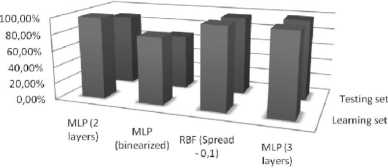8002824268
18 Bartosz Bielski, Przemysław Klęsk
Table 1. Operating systems classes
|
Pos. |
OS class |
Number of examples |
|
1. |
Windows |
599 |
|
2. |
linux |
349 |
|
3. |
bsd |
169 |
|
4. |
other |
164 |
|
5. |
Solaris |
132 |
|
6. |
unix |
94 |
|
7. |
mac_os |
89 |
|
8. |
network modem/router |
83 |
|
9. |
cisco device |
44 |
|
10. |
network printer |
39 |

|
MLP(2 layers) |
MLP(binearized) |
RBF (Spread - 0,1) |
MLP (3 layers) | |
|
■ Learning set |
99,46% |
81,30% |
100% |
99,80% |
|
■ Testingset |
88% |
67% |
95,75% |
97,70% |
Figurę 3. Results of recognition by many kinds of neural networks
When the knowledge and trust drops and especially when we cannot trust remote systems are clean and unmodified, neural network get really good prediction results. The good scores are especially valuable when there is no strict signature in the database of operating systems so that system cannot be recognised at all.
As seen on Figurę 4 we compared best neural network from earlier researches (3-layer multi layer perceptron network - MLP with 10 neurons in every hidden layer) with multi-stage neural network architecture that can detect operating system version
Wyszukiwarka
Podobne podstrony:
16 Bartosz Bielski, Przemysław Klęsk broad networks. Moreover, it can cause some network devices to
20 Bartosz Bielski, Przemysław Klęsk4.1. Greedy induction of decision rules Say we want to find all
Intelligent building, automated... 219 Table 1 Chart showing the increase in the number of car parks
56 Table 2.1 Sample sizes presented relative to the number of capture per bird. 1 Number of
Systemy partyjne współczesnego świata ve Number of Parties: A Measure with Application to West Europ
56 Table 2.1 Sample sizes presented relative to the number of capture per bird. 1 Number of
Passive operating system fingerprinting using neural networks and induction of decision rules Bartos
system motywacyjny 7 18 Rozwój nowoczesnego przemysłu ogranicza coraz bardziej zakres akordowej form
f49 1 w Anonymous ftp sile Operating system f ileś
t t Applied Ergortomics 1987. 18.2, 146-152lnvestigation oi optimal table height and surface angle
P1100051 (3) 244 Rozdział 7 przemysłowego były przemyślane. Niemiecka rada zakładowa i system współd
System operacyjny (ang. Operating System, skrót OS) -oprogramowanie zarządzające systemem komputerow
więcej podobnych podstron